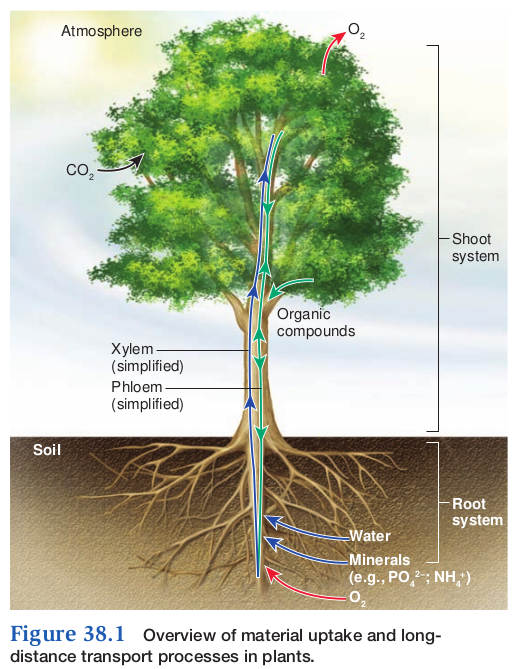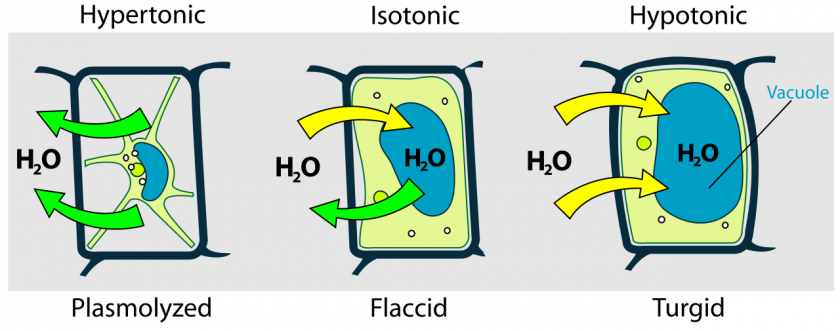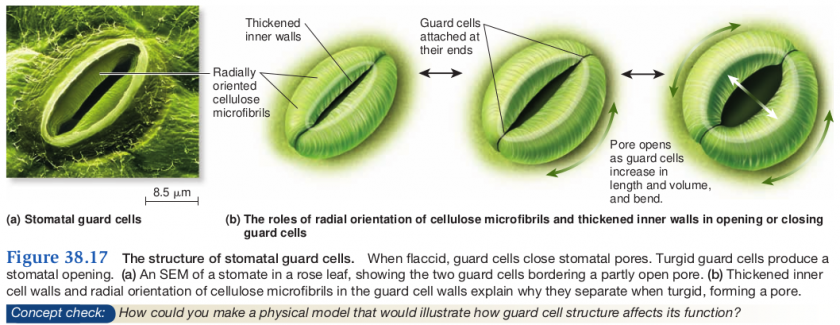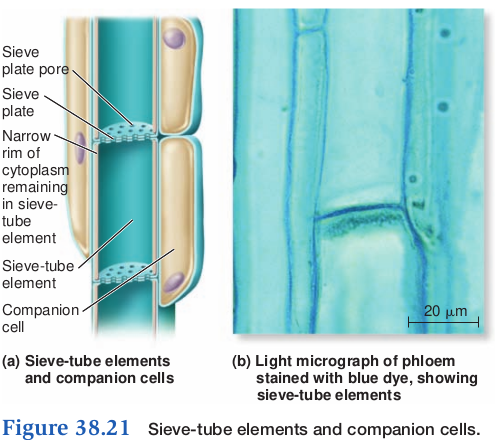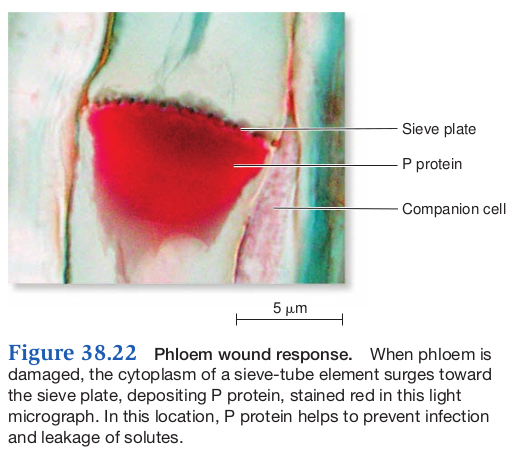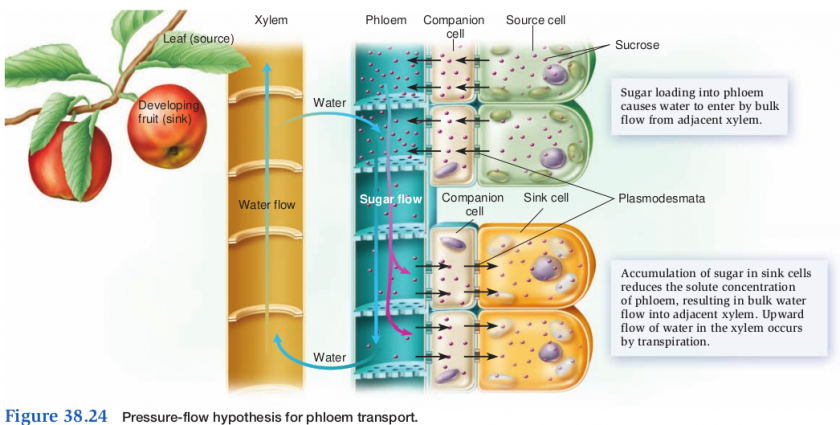Chapter 38
Transport of materials in plants
- Root system absorbs water and dissolved minerals from the soil
- Shoot system takes CO2 from the atmosphere via stomata
- Photosynthetic cells use these materials to produce organic compounds needed for growth and reproduction
- long-distance transportation occurs withing the plant body using a continuous system of conducting materials
- Xylem
- transport water and dissolved minerals
- Only goes up
- Phloem
- transports food and other solutes (hormones)
- Goes up and down
- Xylem
Importance of water
- Photosynthesis
- support of plant organs
- conduction
- cell elongation
- most chemical reactions
- Average plant is 90% water
- Solvent for most substances
- Solution
- Solvent
- Solute
- Solution
Properties of water
- Polar molecule
- neutral
- Hydrogen bonding
- Cohesiveness
- Adhesiveness
- Temperature Stabilizer
- Transport medium
- Best biological solvent
- Occurs in all 3 forms of matter within earth's temperature range
Principles of movement
- Bulk\Mass flow
- Mass movement of liquid cause by pressure and\or gravity
- Ex: leaching
- movement of ion though soil to plant roots
- Faster than diffusion
- Diffusion
- high concentration > low concentration
- Simple diffusion
- Movement of molecules through a phospholipid bilayer down a concentration gradient
- Facilitated Diffusion
- transport of molecules across a plasma membrane down a concentration gradient with the aid of membrane protiens
- Osmosis"gatekeeper"
- Diffusion across a selectively permeable membrane in response differences in solute concentration
- simple diffusion of water does not occur rapidly enough for rapid expansion of plant cells
- Aquaporins
- protein channels that allow facilitated diffusion of water
Tissue-level transport
- trans-membrane transport
- export of material via membrane proteins, followed by import of the same substance by an adjacent cell
- Ex. Auxin transport aided by carrier protiens
- Symplastic Transport
- Movement from cytosol of one cell to cytosol of another cell via plasmodesmata
- Cytosol
- Everything inside the cell wall
- Cytosol
- Movement from cytosol of one cell to cytosol of another cell via plasmodesmata
- Apoplastic transport
- movement along cell walls and inter-cellular spaces
- Ex: water and disolved minerals
Cellular water content
- water content of plant cells depends on osmosis, which depends on:
- Solute concentration
- Turgor preassure
- hydrostatic pressure that increases as water enters plant cells
- cell walls restrict the extent to which the cells can swell
-
- Turgid plant cell has cytosol full of water and plasma membrane pushes up against the cell wall
- Plasmolyzed cell has lost so much water that turgor pressure is lost and the plasma membrane no longer presses on the cell wall
Water potential
- Potential energy of water
- Water moves from highest to lowest water potential
- affected by
- pressure
- solute concentration
- other factors (damage, temperature)
- affected by
- Concept used in 2 ways
- to understand the movement of water into and out of cells (cellular water potential)
- to understand the movement of water between entire plants and their enviroments
Water (and soil mineral) movement through the plant
- Transpiration
- Evaporation of water from plant surfaces
- "cost" for the plant to live on land
- capable of pulling water up by bulk flow
- primary form of long distance water transportation in plants
- Stomata
- Opening has 2 guard cells
- control balance of CO2, O2, and H2O inside leaf
- Opening has 2 guard cells
Xylem
- Flowering plant xylem consists of 4 types of cells
- Xylem parenchyma cells
- Thick-walled supportive fibers
- may be alive or dead at maturity
- vessel elements
- Speacilized water conducting cells and are always dead and empty of cytosol when mature
- Wide tubes
- Tracheids
- tracheory elements
- Rich in lignin which offers strength, durability, and water proofing
- Narrow tubes
- tracheory elements
Stomata
- Plants produce a waxy cuticle to prevent water loss
- stomata facilitate gas exchange
- 90% of water that evaporates from plants is lost through stomata
- when stomata are open, O2 and water vapor are released and CO2 is taken up
- controlled by guard cell pairs
Mechanisms of Guard cells
- Daytime/sunlight
- CO2 is low in leaf
- Guard cells "pump" in K (potassium)
- Changes solute concentration
- H2O from xylem moves by osmosis onto guard cells
- cells become turgid
- Guard cells swell and open stomata
- CO2 diffusion into leaf
- "Pump" out K (potassium)
- H2O moves out by osmosis out of guard cells causing shrinking
- Pumping
- Expenditure of ATP energy
Causes of water loss
- Sunlight energy
- heats up leaf causing evaporating of H2O from mesophyll cells
- Causes a decrease in H2O concentration causing a "pull" of H2O
- This "pull" moves H2O though the "Transpiration stream"
Transpiration Stream
- Soil H2O (and nutrients)
- root epidermis
- root cortex
- endodermis
- root xylem
- stem xylem
- leaf xylem
- mesophyll
- Vapor into atmosphere
Unidirectional movement
Only goes UP!
C-A-T Mechanism
- Occurs once the stomata are open
- Purely a physical process
- "pull" of H2O one molecule at a time
- unidirectional movement
-
Cohesion
- H2O molecules stick together
- Adhesion
- H2O adheres to cellulose in cell walls
-
Tension
- "pull" due to H2O loss from mesophyll
- NO ENERGY expended
- Only energy is sunlight heating leaf
Solute movement in plants
- Translocation
- movement of solutes in plants
- food
- dissolved in H2O
- Moved in form of Sucrose
- Goes form Source to Sink
- Site with excess of carbohydrate
- Site where the carbohydrate is stored or immediately needed
- Bidirectional
Long-distance transport in phloem
- Phloem transports sugars from where they are produced and\or stored to other sites where they are stored and/or needed
- Source > Sink
- Primary Phloem
- Occurs in the vascular bundles of herbaceous plants
- Secondary Phloem
- Occurs as the inner bark of woody plants
Phloem Structure
- Phloem of flowering plants in composed of supporting fibers, parenchyma cells, sieve-tube elements, and adjacent companion cells (members)
- Sieve-tube members (STM) are arranged end-to-end , and together with companion cells, form a system to transport soluble organic substances
- Sieve-tube members lose their nucleus and most of the cytoplasm to reduce obstruction to bulk flow
- phloem sap passes through sieve plate pores
Pressure Flow Hypothesis
At source
- Companion cells "pump" sucrose into STM (STP expended)
- As sucrose concentration increases in STM, water potential (concentration) decreases within STM
- Adjacent Xylem has higher water potential than STM, H2O moves into STM by osmosis
Bulk flow of Sucrose
Higher Pressure > lower Pressure
At sink
- Companion cells unload sucrose (ATP expended)
- Sucrose converted into starch for storage in root cortex
- Without sucrose, higher H2O potential in STM
- H2O moves from STM to adjacent Xylem by osmosis
- ATP spent only by companion cells at source (loading) and sink (unloading)
- Bulk flow (pressure/potential differences) and osmosis (H2O potential\concentration differences)
- No energy Expended
Similarities Between Translocation and Transpiration
- Both involve conduction
- both involve physical properties of H2O
| Translocation | Transpiration |
|
|

